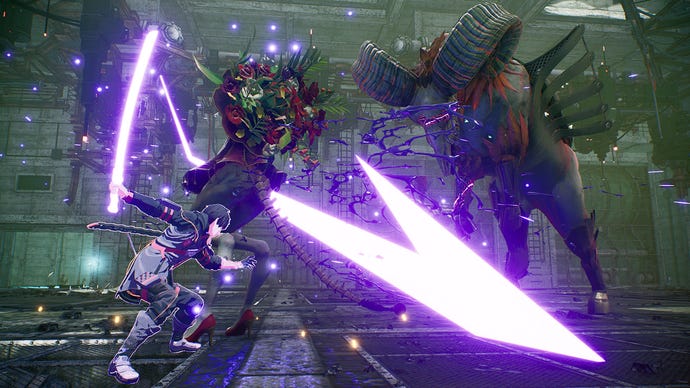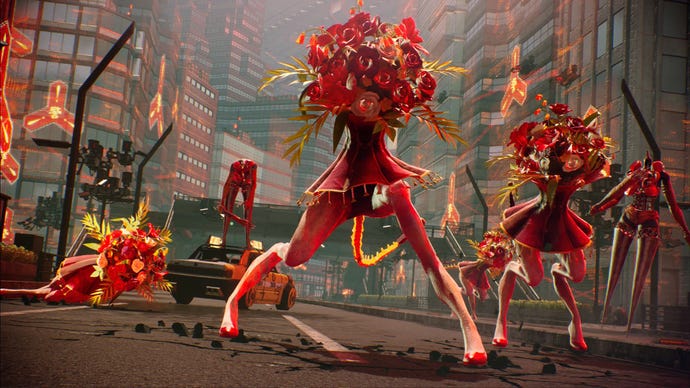Scarlet Nexus is a 'brain punk' action game with some freakish monsters
Think Nier combat with a Persona 5 palette
What if monsters were a kind of weather? That is the question Scarlet Nexus asks, in the form of an anime hack 'n' slash featuring swords and psychic powers. In this future, wub wub music gives way to smooth jazz as you control a crowd of militarised teens who struggle to flirt effectively, yet are entrusted with the future of humanity. Think Nier combat with a Persona 5 palette and some light friendship management. I had the chance to play the opening hours as one of its two playable protagonists (startled boy swordsman Yuito or straight-to-business mind ninja Kasane). I chose Yuito, because he too seemed not to know what was going on around him at any given moment.
Humanity is holding out against demonic creatures in the cyberpunk Suoh City. The monsters are called "Others" and they eat human brains, we are told. They fall from an ever-present cloud that has settled over the world, making them a sort of gruesome cold front (inhabitants of the city even talk about the "Other forecast"). Only the Scarlet Guardians, an elite force of hormonally banjaxed child soldiers, have the special powers to put up a fight against the monsters which threaten it. And why let a good show go to waste? Their fights are broadcasted by the city's media using camera drones. Imagine if firefighters during the Blitz had a live radio show. That's your life now.
Yuito is the cadet youngster from a family of high-ranking city officials. Your brother and father make some aloof appearances via text message in the opening but the people who really matter are your peers, fellow fighters and youngsters. There's a lot of manga panel storytelling, with cinematics becoming static panels and characters exchanging lines of thick exposition at breakneck speed. This might calm down later in the game, but the writers are wasting no time in the first 3-4 hours. There are classic exposition cascades, like the scene where your best friend repeats facts about your family you both should already know. But the game arguably benefits from throwing you into its fast-paced action game world as quickly as possible.
To simplify the anti-monster combat, you chain normal attacks with psychic object-flinging. Yuito can bash stuff with his sword, but he can also move things with his brain. This means hurling cars, vans, concrete, and crates between his sword slashes. There's no aiming involved, just hold down a button to "activate" the nearest tossable box. But there are heavier objects that require more time to lift, and deal greater damage.
The "Others" you're slapping about might have a forgettable name but the creatures themselves are imaginative chimeras of muscle mass, plant matter, machine components and everyday objects. One of them is called a "Brain Yawn" and it is part mannequin leg, part crocodile hump, part fungal infection. There's a touch of Silent Hill to everything you fight, and were it not for the colourful bouquets of flowers and petals erupting from various parts of their weirdo bods, any one of them would be at home in a sluggish survival horror. The ram with sewer manholes for eyes. The horse with a corkscrew head. One boss is part combustion engine, part ape, part flower bed. I'm very fond of him.

Like I've said, it's a little hard to keep up with other characters, being introduced at bullet speed. But they all have their own special powers. There is an ice-flinger, a flame-hoofer, a clairvoyant one who can see invisible enemies, and a telepathic one who becomes a handy form of back-up communication when phones go down. (I'm not being flippant, he admits this himself.) These characters are thrown into the story in such quick succession, you barely have time to register their names. But I think the reason they're introduced so fast is they're not just your mates. They are your abilities.
You can activate the power of whatever buddies are fighting alongside you, see. For example, fight next to cool girl Arashi and you can slow down time. Brawl alongside good-natured tough guy Gemma (pronounced geh-muh) and you can become temporarily invulnerable to an attack. Fight with flame girl Hanabi at your side and you can activate pyrokinesis abilities, setting everything you hit on fire. In this last case, you also use nearby oil barrels to your advantage by mind-lobbing them at baddies before a fiery strike.
You can fight with multiple buds, combining these powers and juggling cooldown meters to adapt to the enemy types you face. For instance, one kind of enemy can turn invisible, so you've got to use Tsugumi the clairvoyant's power to see them. Or you can use stealth lad Kagero's cloaking power to perform a sneak attack before they get a chance to vanish. Combine your buddy-powers with the usual furious girder throwing, and you can stagger an enemy monster, letting you perform a finishing move, delivered as a short cinematic burst of telekinetic violence.

In the opening hours, each character's powers are introduced in a very constrained way, but it looks like you'll be able to swap party members in and out eventually. There's a hideout that feels destined to become the social hub of the story, where you can walk around to jazzy save room music, talk to your comrades, and watch the news. From here you can also launch bonding episodes with your powerpals. These are small story moments or side quests which increase your bond level with that person, unlocking new abilities. As I played, this lull in the action brought a whiff of dating sim to things that I found strangely welcome. A bit of Persona-style friendship management to break up the button bashing.
One side quest had me looking for a watch in an abandoned construction site I'd previously explored, while chatting to the other playable character, sullen psywarrior Kasane. The next bonding episode featured Hanabi, preeminent pyromaniac and your protagonist's childhood friend. Bonding with her didn't involve a side quest but was as simple as listening through some dialogue (she thinks you like another girl, you dirtbag). In the end she is reassured and Hanabi will now leap forward to block some attacks before they hit you. She also gives you a new flaming whirlwind attack. Ah, young love.
The important thing is that fights get cooler the more abilities you unlock. Your skill tree includes a double jump, an aerial dodge, new types of attack, and a smattering of incremental bonuses of the "5% more damage" variety. The pick 'n' mix nomenclature of video games is also healthily present. The name for XP is "Brain Points". I am strongly in favour of this.

I'm cautiously in favour of the whole thing, to be honest. I like the bonding idea. The city looks great, with augmented reality advertising hogging the gloomy skyline. And the monsters are unusual enough to wonder what the hell is going on. Right from the start there is some mystery to events. Why does the city's AR cybernet censor some things from view? What happened to Yuito's mother? Why is it raining monsters when the weatherman said it would be nice today?
From my brief skirmishing, Scarlet Nexus feels like a competently made thing. It also appears to know exactly who it's gunning for. Nier players, Persona players, Tales of Nonsensia players. In terms of genre it's not precisely like any of those games, but it has a tone that mixes all three. It feels unlikely to be the slash-o-hack for anyone who cringes at anime lore delivery. But it might turn out a nice pandemic ointment for those who like to whisk swords, who enjoy a good monster, and who find it endearing to see the blushing awkwardness of superpowered children figuring out their crushes in the middle of a surreal war.
I'm hopeful for more populated zones and perhaps some brakes being applied to the rapid worldbuilding. But I'm also aware that in a hack and slash where other people are your power-ups, not everyone is likely to get a chapter of slow-burn character development. I still don't know these child soldiers well enough to have a favourite, but it might be shopkeeper and living save point Satori, who appears like an ominous raven before big battles, a classic save game soothsayer. "Do not try to interact with me beyond my job," he says. "That is best for both of us." A relatable statement from a man I respect.




